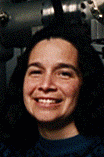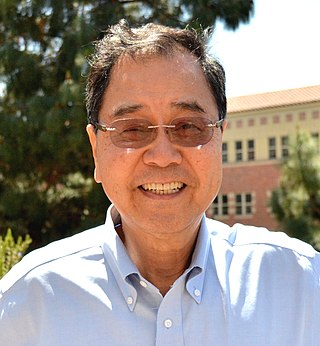Related Research Articles

Herbert Kroemer was a German-American physicist who, along with Zhores Alferov, received the Nobel Prize in Physics in 2000 for "developing semiconductor heterostructures used in high-speed- and opto-electronics". Kroemer was professor emeritus of electrical and computer engineering at the University of California, Santa Barbara, having received his Ph.D. in theoretical physics in 1952 from the University of Göttingen, Germany, with a dissertation on hot electron effects in the then-new transistor. His research into transistors was a stepping stone to the later development of mobile phone technologies.
Engineering physics, or engineering science, refers to the study of the combined disciplines of physics, mathematics, chemistry, biology, and engineering, particularly computer, nuclear, electrical, electronic, aerospace, materials or mechanical engineering.
Arthur C. Gossard was a professor of materials and electrical engineering at the University of California, Santa Barbara. In 1982, he co-discovered the fractional quantum Hall effect. His research is related to molecular beam epitaxy (MBE). He has a doctorate in physics from UC Berkeley. After university, he joined Bell Labs.

Maria C. Tamargo is a leading Cuban-American scientist in compound semiconductors and materials science. She is a professor of chemistry at The City College of New York.

Jonathan P. Dowling was an Irish-American researcher and professor in theoretical physics, known for his work on quantum technology, particularly for exploiting quantum entanglement for applications to quantum metrology, quantum sensing, and quantum imaging.

Supriyo Datta is an Indian–American researcher and author. A leading figure in the modeling and understanding of nano-scale electronic conduction, he has been called "one of the most original thinkers in the field of nanoscale electronics."

Kang Lung Wang is recognized as the discoverer of chiral Majorana fermions by IUPAP. Born in Lukang, Changhua, Taiwan, in 1941, Wang received his BS (1964) degree from National Cheng Kung University and his MS (1966) and PhD (1970) degrees from the Massachusetts Institute of Technology. In 1970 to 1972 he was the Assistant Professor at MIT. From 1972 to 1979, he worked at the General Electric Corporate Research and Development Center as a physicist/engineer. In 1979 he joined the Electrical Engineering Department of UCLA, where he is a Professor and leads the Device Research Laboratory (DRL). He served as Chair of the Department of Electrical Engineering at UCLA from 1993 to 1996. His research activities include semiconductor nano devices, and nanotechnology; self-assembly growth of quantum structures and cooperative assembly of quantum dot arrays Si-based Molecular Beam Epitaxy, quantum structures and devices; Nano-epitaxy of hetero-structures; Spintronics materials and devices; Electron spin and coherence properties of SiGe and InAs quantum structures for implementation of spin-based quantum information; microwave devices. He was the inventor of strained layer MOSFET, quantum SRAM cell, and band-aligned superlattices. He holds 45 patents and published over 700 papers. He is a passionate teacher and has mentored hundreds of students, including MS and PhD candidates. Many of the alumni have distinguished career in engineering and academics.

Gerhard Klimeck is a German-American scientist and author in the field of nanotechnology. He is a professor of Electrical and Computer Engineering at Purdue University School of Electrical and Computer Engineering.

Sanjay Banerjee is an American engineer at the University of Texas at Austin, director of Microelectronics Research Center, and director of the Southwest Academy of Nanoelectronics (SWAN) — one of three such centers in the United States funded by the Semiconductor Research Corporation to develop a replacement for MOSFETs as part of their Nanoelectronics Research Initiative (NRI).
Roger John Malik is a physicist, engineer and inventor.
Christian Schönenberger is a Swiss experimental physicist and professor at the University of Basel working on nanoscience and nanoelectronics.
Manijeh Razeghi is an Iranian-American scientist in the fields of semiconductors and optoelectronic devices. She is a pioneer in modern epitaxial techniques for semiconductors such as low pressure metalorganic chemical vapor deposition (MOCVD), vapor phase epitaxy (VPE), molecular beam epitaxy (MBE), GasMBE, and MOMBE. These techniques have enabled the development of semiconductor devices and quantum structures with higher composition consistency and reliability, leading to major advancement in InP and GaAs based quantum photonics and electronic devices, which were at the core of the late 20th century optical fiber telecommunications and early information technology.
Santosh Kurinec is an IEEE fellow and a professor of Electrical & Microelectronic Engineering at Kate Gleason College of Engineering in Rochester Institute of Technology (RIT). She is an Indian American electronic engineer specializing in electronic materials and devices. She is a former IEEE Electron Devices Society distinguished lecturer. In 2018, she was inducted into the Women in Technology International (WITI) Hall of Fame.
Leslie Ann Kolodziejski is an American professor of electrical engineering at the Massachusetts Institute of Technology. She works on fabricating novel photonic devices after synthesizing the constituent material via molecular-beam epitaxy. She is a recipient of the Presidential Young Investigator Award from the National Science Foundation and is a fellow of The Optical Society.

Deblina Sarkar is an electrical engineer, and inventor. She is an assistant professor at the Massachusetts Institute of Technology (MIT) and the AT&T Career Development Chair Professor of the MIT Media Lab. Sarkar has been internationally recognized for her invention of an ultra thin quantum mechanical transistor that can be scaled to nano-sizes and used in nanoelectronic biosensors. As the principal investigator of the Nano Cybernetic Biotrek Lab at MIT, Sarkar leads a multidisciplinary team of researchers towards bridging the gap between nanotechnology and synthetic biology to build new nano-devices and life-machine interfacing technologies with which to probe and enhance biological function.

Paul R. Berger is a professor in electrical and computer engineering at Ohio State University and physics, and a distinguished visiting professor (Docent) at Tampere University in Finland, recognized for his work on self-assembled quantum dots under strained-layer epitaxy, quantum tunneling based semiconductor devices and solution processable flexible electronics.
Huili Grace Xing is the William L. Quackenbush Professor of Electrical and Computer Engineering, and Materials Science and Engineering in the Cornell University College of Engineering. In 2019, Xing was elected a Fellow of the American Physical Society (APS) "for pioneering contributions in polar wide-bandgap semiconductors, 2D crystal semiconductors and layered crystals," as well as Fellow of the American Association for the Advancement of Science (AAAS) in 2021.
April S. Brown is an American electrical engineer and materials scientist in the Duke University Pratt School of Engineering, where she is a professor of electrical and computer engineering and the former John Cocke Professor of Electrical and Computer Engineering.
Kei May Lau is a semiconductor engineer whose research topics have included high-electron-mobility transistors, light-emitting diodes, and laser diodes. She is Fang Professor of Engineering and Director of the Photonics Technology Center in the Hong Kong University of Science and Technology Department of Electronic & Computer Engineering.

Supriyo Bandyopadhyay is an Indian-born American electrical engineer, academic and researcher. He is Commonwealth Professor of Electrical and Computer Engineering at Virginia Commonwealth University, where he directs the Quantum Device Laboratory.
References
- ↑ "Women in Engineering: Theda Daniels Race". Louisiana State University College of Engineering. Retrieved 2020-07-01.
- ↑ "Theda Daniels-Race - Share Your Road". roadtripnation.shareyourroad.com. Retrieved 2020-07-01.
- 1 2 "Dr. Theda Daniels-Race and her award-winning group". www.ece.lsu.edu. Retrieved 2020-07-01.
- 1 2 "Dr. Theda Daniels-Race to Present Seminar September 9 – Institute of Computing and Cybersystems (ICC) Blog". 4 September 2019. Retrieved 2020-07-01.
- ↑ "Theda Daniels-Race – AAWIP" . Retrieved 2020-07-01.
- ↑ "Dr. Race's webpage - Biography". www.ece.lsu.edu. Retrieved 2024-03-18.
- ↑ "A Spectrometric Study of High-Energy Electronics Using Planar-Doped Barrier Launchers by T.M. Daniels-Race" . Retrieved 2020-07-01.
- ↑ Daniels-Race, Theda Marcelle (1990). A spectrometric study of high energy electrons using planar doped barrier launchers. Cornell University.
- ↑ "The Physicists – AAWIP" . Retrieved 2020-07-01.
- ↑ Petersen, Anne C. (1997-03-01). Women and Science: Celebrating Achievements, Charting Challenges, Conference Report. DIANE Publishing. ISBN 978-0-7881-7886-3.
- ↑ "Dr. Race's webpage - Biography". www.ece.lsu.edu. Retrieved 2020-07-01.
- ↑ "Theda Daniels-Race, Ph.D." (PDF). Michigan Tech University Blog. Retrieved 2020-07-01.
- ↑ Daniels-Race, Theda (2003-04-30). "Growth and Characterization of MBE Parametric Variations Upon Polarization Independent Strained Films". doi: 10.2172/837876 . OSTI 837876 .
{{cite journal}}: Cite journal requires|journal=(help) - ↑ Daniels-Race, Theda; Banoo, Kausar (1997-05-28). "Engineering the I-V characteristics of an asymmetric double barrier device with variable period GaAs/AlAs superlattice injectors". Thin Solid Films. 300 (1): 202–207. Bibcode:1997TSF...300..202D. doi:10.1016/S0040-6090(96)09392-3. ISSN 0040-6090.
- ↑ Li, Hanxuan; Daniels-Race, Theda; Hasan, Mohamed-Ali (2002-02-22). "Effects of the matrix on self-organization of InAs quantum nanostructures grown on InP substrates". Applied Physics Letters. 80 (8): 1367–1369. Bibcode:2002ApPhL..80.1367L. doi:10.1063/1.1452784. ISSN 0003-6951.
- ↑ Li, Hanxuan; Wu, Ju; Wang, Zhanguo; Daniels-Race, Theda (1999-08-16). "High-density InAs nanowires realized in situ on (100) InP". Applied Physics Letters. 75 (8): 1173–1175. Bibcode:1999ApPhL..75.1173L. doi:10.1063/1.124633. ISSN 0003-6951.
- ↑ "Pfund Program More Than Reaches Goal" (PDF). Louisiana Experimental Program to Stimulate Competitive Research (Vol.4, No.5). Retrieved 2020-07-01.
- ↑ "Louisiana State University - Theda Daniels-Race". lsu.edu. Retrieved 2020-01-07.
- ↑ University, Michigan Technological. "Dr. Theda Daniels-Race Seminar". Michigan Tech Events Calendar. Retrieved 2020-07-01.
- ↑ "Social media celebrates Feb. 11 as International Day of Women and Girls in Science". WBRZ. Retrieved 2020-07-01.
- ↑ "Women Making History" . Retrieved 2020-07-01.
- ↑ Sarkar, Anirban; Wang, Hao; Daniels-Race, Theda (2014-03-01). "Surface enhanced Raman spectroscopy on silver-nanoparticle-coated carbon-nanotube networks fabricated by electrophoretic deposition". Electronic Materials Letters. 10 (2): 325–335. Bibcode:2014EML....10..325S. doi:10.1007/s13391-013-3147-6. ISSN 2093-6788. S2CID 137479893.
- ↑ Maulik, Subhodip; Basu, Srismrita; Kanakamedala, Kalyan; Daniels-Race, Theda (2019-06-01). "A Review of Atomic Scale Characterization Techniques of Molybdenum Disulfide (MoS2)". Journal of Electronic Materials. 48 (6): 3451–3458. Bibcode:2019JEMat..48.3451M. doi:10.1007/s11664-019-07079-9. ISSN 1543-186X. S2CID 108161836.
- 1 2 "Panel Discussion: The Underrepresented Majority" (PDF). American Physical Society. Retrieved 2020-07-01.
- ↑ "Advisory Board Members". School of Science & Engineering. 2019-02-06. Retrieved 2020-07-01.
- ↑ "Hybrid Electronic Materials: Nanotechnology Reality vs. Nanobots, Grey Goo and Other Strange Stuff — LSU Honors College". www.honors.lsu.edu. Retrieved 2020-07-01.
- ↑ "2014 Conference for Undergraduate Women in Physics - January 17-19, 2014". www.phys.lsu.edu. Retrieved 2020-07-01.
- ↑ "Theda Daniels-Race - Roadtrip Nation". roadtripnation.com. Retrieved 2020-07-01.
- ↑ Feldman, M. (2014-02-13). Nanolithography: The Art of Fabricating Nanoelectronic and Nanophotonic Devices and Systems. Woodhead Publishing. ISBN 978-0-85709-875-7.